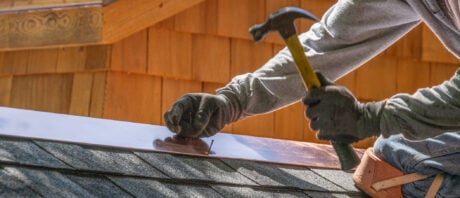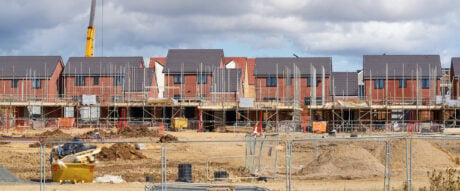The idea of having an in-ground pool excites many homeowners. It’s a place to cool down during the hot summers and go for a swim in complete privacy.
While there’s no denying the pleasure, the cost to install an in-ground pool in Canada can be surprisingly high. In addition, you’ll need to factor in the ongoing expenses necessary to keep your pool safe and functional year after year.
How much does an inground pool cost in Canada?
| Type of Pool | Typical Price Range |
|---|---|
| Vinyl liner | $20,000 to $90,000 |
| Fibreglass | $75,000 to $100,000 |
| Concrete | $50,000 to $200,000+ |
Price ranges reflect averages sourced from sites like Moneysense[1], Simplypools.ca[2] and Jordco Pools[3]. Your in-ground pool installation costs may vary.
Factors that affect the cost of an inground pool
When you start researching inground pool costs, you quickly realize that the ranges in quotes can be quite drastic depending on your desires, location, and other factors. In addition, if you seek out quotes from multiple pool installers, you will likely get very different prices. When budgeting for a pool install, consider these factors that will affect your overall costs.
DIY installation vs. professional installation
In most cases, you’ll need to hire a team of experienced, knowledgeable professionals to install your pool. . As you can imagine, that experience comes at a cost, but they’ll likely be able to complete the job quickly and effectively — and to a high standard of quality.
If you consider taking the do-it-yourself route, you may save money. That said, installing an inground pool is no small task. You’d need to excavate the pool site, install the pool, and landscape around it.
Pool installation is not a one-person job, and it requires specialized equipment and skills, and you’ll likely still need to hire some contractors to help you complete the work.
Permitting
Before you begin construction on your pool, you’re going to need to get permits.
The rules for permits depend on your municipality, but you’ll typically need structural drawings of your property, pool dimensions, setbacks, enclosures and more. And if you live in a conservation area, you may need additional permission.
Generally, your contractor or pool installer will help you obtain all the permits on your behalf. In most cases, the cost of the permits is included in their quote.
Type of pool
The type of pool you install has arguably the greatest impact on your budget. That said, each type of inground pool has its own pros and cons worth considering:
Vinyl
If you’re looking to keep your costs as low as possible, vinyl is your cheapest option. Vinyl-liner pools allow you to choose the shape, size and depth of your swimming area.
Even though they’re affordable to install, vinyl pools have upkeep costs to consider. Annual maintenance could cost between $3,000 and $6,000. You’ll need to replace the liner every seven to 10 years, which could set you back $3,000 to $7,000.
Fibreglass
The mid-range cost option for inground pools is fibreglass.
Fibreglass pools cost slightly more than vinyl, but require the least amount of maintenance.
Fibreglass pools come pre-fabricated, which may limit your customization options in terms of size and shape. On a positive note, they are typically quicker to install than other options.
Concrete/cement
For those looking for top quality, a concrete pool is the way to go. Unfortunately, getting the best product also comes with the highest price tag. In addition, concrete pools typically require the most maintenance of all inground pools. Despite their higher price tag, concrete pools are the most customizable and typically last the longest of any inground pool.
Size and shape
As you can imagine, the size and shape of your pool will also have an impact on your overall cost.
- Large vs. small. Naturally, a larger pool will cost more than a smaller one. That’s because a larger pool requires more materials, excavation, landscaping and water.
- Rectangular vs. custom shape. Generally, rectangular pools will be cheaper than custom shapes. However, instead of focusing on the price, think about your needs. If you’re going to use your pool for fitness, a rectangle might make the most sense, since it’s easier to do laps. If your goal is leisure, a custom shape may be worth the investment.
Amenities
Another reason why the cost of installing a pool can add up quickly is the amenities. Although most amenities are optional, many homeowners will consider a few of them as they create their backyard oasis.
- Decking. This area that surrounds your pool doesn’t have to be elaborate, and many people opt for a basic concrete deck. However, you can add a splash pad, deck and lounge area to maximize your space.
- Water features. Adding water features such as a waterfall, ladder, diving board, waterslide, fountain or hot tub can increase your costs significantly.
- Fencing. A four-sided fence around your pool is required by law in some municipalities, and is generally a good idea for safety. The cost to install a fence can vary depending on the type of fence you’re installing and the type of door or gate you choose.
- Landscaping. Depending on your plans, this landscaping can be fairly simple or elaborate and expensive.
- Heat. The temperature of your pool’s water may determine how often you swim. A heating system can extend your swimming season, but it will also increase your installation costs.
Other inground pool costs to consider
Installing an inground pool comes with a huge upfront cost, but you’ll also need to consider quite a few ongoing costs, such as:
- Home insurance. Adding a pool to your home will increase your home insurance premiums. The amount of that increase will depend on factors such as safety measures, pool size and type of water features. You may also need to add flood damage to your policy.
- Utility bills. You can expect both your water and utility bills to increase after installing a pool, since you’ll need to maintain water levels, run filtration equipment and potentially heat the pool.
- Upkeep and maintenance. You’ll need to regularly replenish the chemicals used to keep your pool clean. You may also need to pay for repairs or replacement items through the years.
- Winterization. Closing your pool won’t cost much, but it’s something you’ll need to do every winter. Tasks include emptying your pool, blowing out the water lines and installing your pool cover.
Alternatives to an inground pool
If you find the cost of installing an inground pool to be too high for your liking, there are many alternatives available, including:
- An above-ground pool. Installing a pool above ground could be a much less expensive option. It may not look as good as inground options, but at least you’re still getting a private pool at home.
- An inflatable pool. If your goal is to simply keep the kids cool during the summer, an inflatable pool could meet your needs. These types of pools are inexpensive and typically come with a pump, so they only take a few minutes to inflate. You’ll then fill the pool with water from your hose.
- Public or community pools. Just about every city in Canada has a free public or community pool with open swim times, and usually reasonable prices.
- Splash pads or water parks. Splash pads and water parks have become very popular within communities. You won’t be able to swim, but you’ll be able to cool off during the summer.
- Pools at your gym or country club. Some gyms and country clubs have pools for members to use. If your closest gym doesn’t have a pool, ask whether your membership gives you access to another location that does have a pool.
- Condo pools. Many condos and apartment buildings in Canada include pools. These pools are free to residents, and they can usually invite guests to enjoy them as well.
- Lakes, rivers and oceans. Depending on where you live, you may have easy access to lakes, rivers or ocean beaches where you can swim. Some local beaches even have lifeguards working during the summer.
Frequently asked questions about inground pool installation costs
Having an inground pool could potentially add value to your home. However, a professional appraiser will consider your pool as just one factor of many factors during the home appraisal. Conversely, a pool could potentially reduce the number of people interested in buying your home in the future, as potential homeowners may not want to deal with the maintenance or may be concerned about safety.
A vinyl-liner pool is the cheapest inground pool option.
Article Sources
-
MoneySense, “How much does a swimming pool cost in Canada?,” accessed July 10, 2024.
-
Simply Pools, “Fibreglass Pool Installation,” accessed July 10, 2024.
-
Jordco Pools, “How Much does An In-Ground Pool Cost?,” accessed July 10, 2024.
DIVE EVEN DEEPER

Should You Use a Personal Loan for Home Improvements?
Personal loans are funded quickly and feature lower interest rates than credit cards, but may be too restrictive for major home improvement projects.

The Greener Homes Grant and Other Money-Saving Programs for Homeowners
Canada’s Greener Home Grant is just one of many programs and incentives that can help you pay for upgrades and retrofits that make your home more efficient.

These Upgrades May Shrink Your Home Insurance Costs
Upgrades like a new roof, security system or water alarm make your house safer and less susceptible to damage — and may result in lower home insurance premiums.


